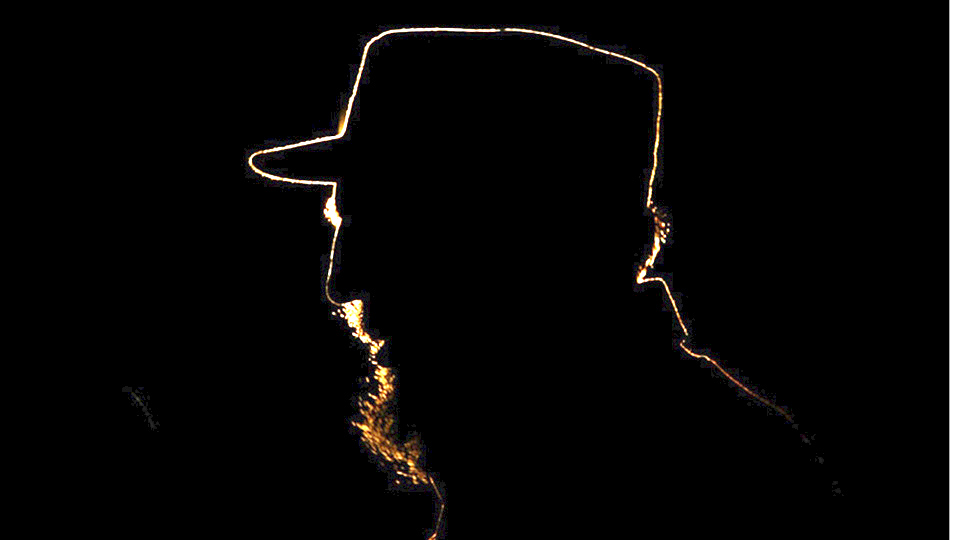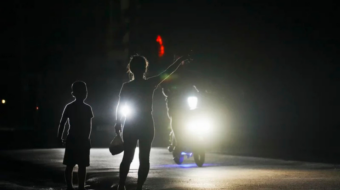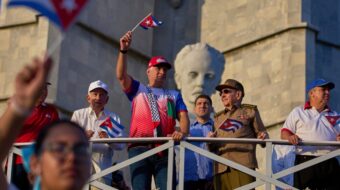
On Nov. 25, the Cuban people and the world got the news that Fidel Castro Ruz had passed on into history.
Fidel had stepped down as president of Cuba in 2006, having formally resigned in 2008 due to health problems. He relinquished his post as head of the Communist Party of Cuba in 2011. But he continued to write and to receive visitors from all over the world. In April of 2016, Fidel attended a Congress of the Cuban Communist Party, where he told delegates that this would probably be the last time he would meet with them, as he did not expect to live much longer. He was saying goodbye.
As with many of the things Fidel predicted over the years, this has now come true.
Fidel’s early life
It would take volumes to do justice to Fidel Castro’s contributions.
Fidel Castro Ruz was born in 1926, the son of immigrants from the Galicia region of Spain. He spent his early childhood on his parents’ farm until being sent to study at a series of three schools. The last, El Colegio de Belen in Havana, left a strong impression on him. Though sharing neither their ideology nor their theology, Fidel always expressed gratitude to the Jesuit fathers who taught him the importance of intellectual rigor and personal discipline.
He began studies at the University of Havana in 1945, majoring in law. At that time, Cuban politics were in a state of uproar, and student politics at the university were fully involved. Criminal gangs, allied with the corrupt government of President Grau San Martin, sometimes invaded the campus and fought it out with politicized students. Again, Fidel was in the thick of things, sometimes with his life literally on the line.
Fidel showed his commitment to international solidarity against oppression early on with his involvement in a failed effort in 1947 to launch an expedition to overthrow Rafael Leonidas Trujillo, the U.S.-backed dictator of the Dominican Republic. Visiting Bogotá, Colombia in 1948, Fidel found himself in the middle of the street conflict that followed the assassination of progressive presidential candidate Jorge Eliécer Gaitán. These experiences gave Fidel an understanding that the injustice and corruption against which he was fighting in Cuba were part of a pattern in poorer countries in which imperialist forces collaborated with corrupt national elites to keep workers and small farmers from claiming their rights.
Revolution and backlash
Fidel was familiar with the works of Marx, Engels and Lenin, but also was influenced by the national heroes of the 19th Century Cuban movement for independence from Spain, especially José Martí. Fidel knew members of the Cuban Communist Party, or People’s Socialist Party (PSP), as it was then known, but did not initially join it. Rather, he at first worked within the Ortodoxo Party of Eduardo Chibás, whom he greatly admired. But Chibás committed suicide as a protest against the corruption and lack of democracy in the country. After former president Fulgencio Batista grabbed control of Cuba in a military coup in March 1952, Fidel Castro and his allies first tried legal means to reverse the coup. When those got nowhere, they turned to armed action. On July 26, 1953, they launched an armed assault on the Moncada army barracks in the city of Santiago. The attack failed and many of the revolutionaries were rounded up and murdered by Batista’s troops and police.
In court, Fidel defended himself, pointing out that the Batista government could not accuse him and the July 26 movement of violating the constitutional order, because Batista himself violated the constitution by taking power in a coup. Nevertheless, Fidel and others were given jail sentences (in his case, 15 years). Public pressure induced Batista’s government to release them early. Fidel fled to Mexico, where he joined up with his brother Raul and the Cuban-Argentine doctor cum revolutionary Ernesto “Che” Guevara. Using an old motor boat dubbed the “Granma”, they returned to Cuba with 81 men, coming ashore on Nov. 30, 1956. Batista’s forces killed most of the fighters, but some, including Fidel, Raul and Che, escaped into the mountains to begin a revolutionary insurrection that spread, gained new adherents and eventually drove Batista and his supporters from power on Jan. 1, 1959.
The new government, in which Fidel was given the position of prime minister (he became president of Cuba in 1976), moved fast to right the historic wrongs of workers, campesinos and the poor. It nationalized agricultural and other properties, launched a successful adult literacy program, and initiated public health programs for which Cuba has become famous. Housing and infrastructure were improved, and key businesses and industries were nationalized.
The old Cuban ruling class was enraged. The U.S. government under President Dwight Eisenhower and his successors decided that this challenge to its power could not be tolerated, that Fidel and his colleagues had to go. First the United States stopped buying Cuban sugar, the island’s main export crop, and then broke off diplomatic relations—which were not restored until 2015. There followed a period of U.S.-backed campaigns against Cuba, in which the United States, the right-wing Cuban exiles, and the U.S. and Cuban criminal underground collaborated in acts of sabotage and murder. By some counts, there were more than 600 attempts to assassinate Fidel. With the Bay of Pigs invasion in 1961, CIA-backed Cuban exiles invaded Cuba to overthrow the government of Fidel Castro. Though it was already engaged in trade with the USSR, after Bay of Pigs Cuba turned more decisively to the Soviet Union and the Warsaw Pact countries, which provided Cuba with favorable trade terms and direct military and economic aid.
In 1965, Fidel and his colleagues reorganized the political leadership of the country, combining the old PSP, the Revolutionary Student Directorate and Fidel’s own 26th of July Movement into a united Communist Party of Cuba. Over the years, structures designed to maximize mass participation in government decision-making were created. These structures continue to carry out the functions of the Cuban government to this day.
Inspiring the global left
Under Fidel Castro’s leadership, Cuba became an inspiration and mainstay to poor nations of Africa, Asia and Latin America, which were striving to break free from imperialism and colonialism. In the 1970s and 1980s, Cuba played a major role in the dismantling of the apartheid regime in South Africa. The sacrifice made by Cuban soldiers at the Battle of Cuito Cuanavale, which lasted from August 1987 to March 1988, was instrumental in forcing the South African government to give up the idea of defending apartheid through armed attacks on neighboring countries. The end of apartheid, the release of political prisoners and the first free elections in South Africa, in which Nelson Mandela won the presidency, followed.
Under Fidel Castro’s presidency, Cuba played a major role in the integration of the Latin American nations. Fidel and the late Venezuelan President Hugo Chávez Frías, were the initiators of the Bolivarian Alliance for the Peoples of Our America, or ALBA, which now includes also Bolivia, Ecuador, Nicaragua and a number of Caribbean island states.
Cuban solidarity programs initiated by Fidel Castro, which continue to this day, have saved thousands of lives in poor countries in the Americas and around the world. Cuban doctors, nurses, teachers, engineers and even sports trainers (Fidel was an avid baseball player and scuba diver) have been provided to scores of poor countries irrespective of the politics of the governments in power. Cuba has helped to train many thousands of doctors and other specialists from poor countries around the world. This unstinting and disinterested humanitarian aid helps explain why Cuba is held in such high regard worldwide, and why the efforts of U.S. imperialism to break the Cuban Revolution have failed.
During his life, Fidel Castro made major contributions to humanity’s thinking on a number of vital issues. It was Fidel who promoted the idea that neoliberalism is the last phase of imperialism. He pointed out that the debt burden on poorer countries had not only become unpayable, but should not be paid. He was an early adopter of the campaign against global warming and for biodiversity, making Cuba the greenest nation in the Caribbean. He was instrumental in getting peace talks going in Colombia.
In all these areas, Castro made a contribution to the theory and practice of Marxism. In his hands it was not fossilized dogma but a unique and living guide to the solution of the great problems which beset humankind.
History has absolved him; humanity will never forget him.










